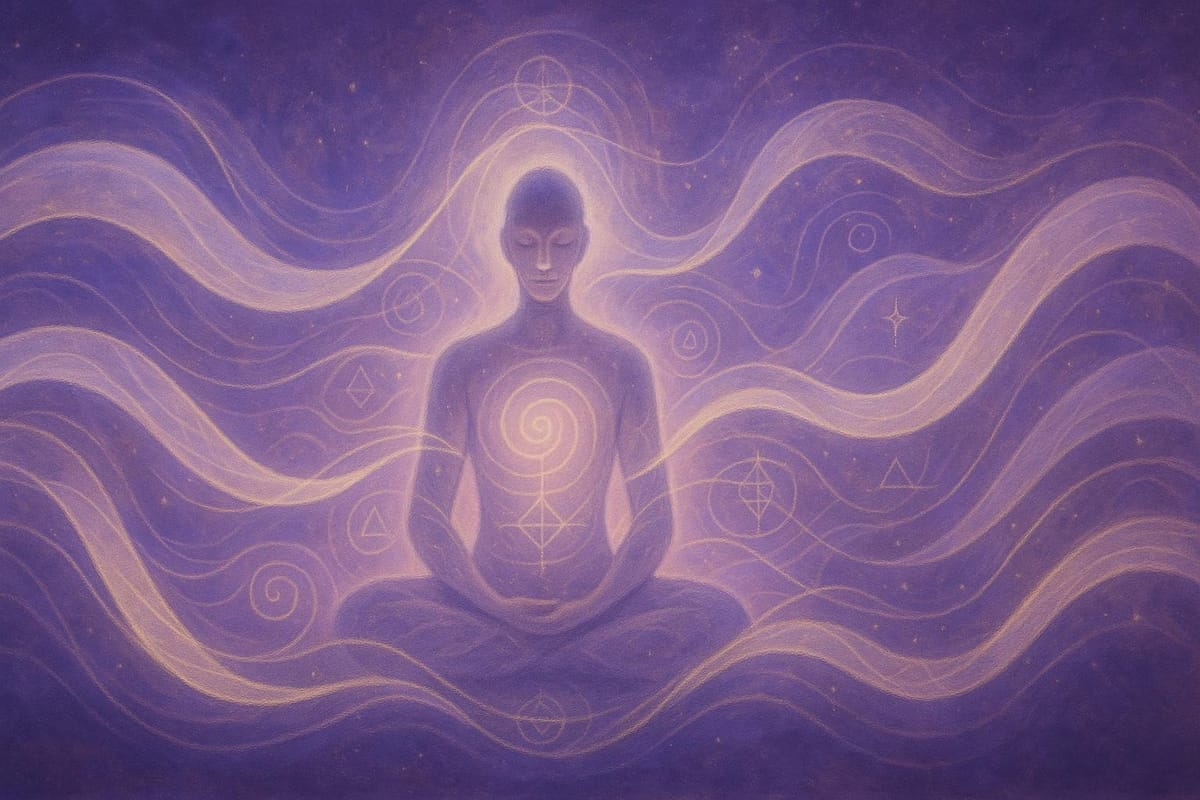Sound-Light Synergy in Healing
Explore the synergy of sound and light therapies in enhancing mental and physical health, promoting relaxation, and supporting healing processes.

Sound and light therapies can work together to improve mental, physical, and emotional health. Combining sound vibrations and light wavelengths enhances relaxation, reduces anxiety, and supports cellular repair. Here’s what you need to know:
- Sound Therapy: Uses vibrations to balance energy, reduce stress, and sync brainwaves for relaxation. Tools like Tibetan bowls, gongs, and tuning forks are commonly used.
- Light Therapy: Involves specific wavelengths to boost mood, regulate circadian rhythms, and heal skin. Devices like red light therapy and UVB lamps are widely used.
-
Combined Benefits: When used together, these therapies can:
- Improve brainwave synchronization
- Speed up cellular recovery
- Reduce anxiety and stress more effectively than either therapy alone
For example, using 40Hz sound and light together has been shown to relax patients and even improve cognitive function. While promising, challenges like cost and practitioner expertise remain.
Quick Comparison:
| Therapy | Key Uses | Benefits |
|---|---|---|
| Sound Therapy | Stress relief, brainwave sync | Reduces anxiety, improves sleep |
| Light Therapy | Mood, skin healing | Enhances energy, alleviates depression |
| Combined Therapy | Relaxation, cellular repair | Faster healing, deeper relaxation |
With ongoing research and advancements, sound-light therapy holds potential as a safe, non-invasive approach to wellness.
1. Sound Therapy Basics
How Sound Therapy Works
Sound therapy taps into the natural vibrations of the universe, and since the human body is made up of about 70% water, sound waves travel through it with ease, gently massaging cells along the way. These vibrations create alternating cycles of compression and relaxation at the cellular level, offering therapeutic effects right where they’re needed.
Two primary mechanisms explain how sound therapy works:
- Resonance: Sound waves interact directly with the body’s tissues, helping to balance energy and promote healing. This process involves the oscillation of molecules, which penetrates deep into tissues, boosting circulation, enhancing metabolism, and easing muscle tension.
- Entrainment: Therapeutic sounds encourage the brain to sync its rhythms with these external vibrations. This natural synchronization helps shift brainwaves from the busy beta state to more relaxed alpha and theta states, fostering deep relaxation and aiding the body’s healing process.
Common Uses and Results
Sound therapy has been shown to be effective in reducing stress and improving overall well-being. For example, a 2016 study found that Tibetan singing bowl meditation significantly lowered feelings of tension, anger, fatigue, and depression in participants. Other reported benefits include reduced anxiety, improved sleep, better mental clarity, enhanced immunity, and lower blood pressure.
Dr. Olivia Hsu Friedman, an expert in Traditional Chinese Medicine, explains the process:
"When human beings hear external vibration, entrainment occurs, or the synchronization of that person's biology with the vibration. This creates a stable frequency, meaning it helps you downshift from normal beta state (normal waking consciousness) to alpha (relaxed consciousness), and even theta (meditative state) and delta (sleep, when internal healing occurs)."
Current Tools and Methods
Modern sound therapy uses a variety of tools and techniques, each designed for specific purposes:
| Tool | Use | Benefits |
|---|---|---|
| Tibetan Singing Bowls | Relaxation | 70% report improved well-being |
| Crystal Bowls | Chakra balancing | Energy alignment |
| Tuning Forks | Targeted healing | Precise frequency application |
| Gongs | Full-body vibration | Tension reduction |
| Voice Toning | Emotional release | Improved self-expression |
Historical and Spiritual Uses
The practice of sound healing has roots in ancient cultures. The Egyptians used musical chants for healing, while Greek physicians relied on instruments like flutes, lyres, and zitters to address various ailments. Australian Aborigines have employed the didgeridoo as a healing tool for over 40,000 years.
Sara Auster, a well-known sound therapist, describes the experience:
"Sound healing is an invitation into a deeper state of consciousness, where you unplug from external stimuli and focus on what's going on within you."
This ancient wisdom continues to shape modern sound therapy, where practitioners use sound to focus healing intentions. These foundational principles also set the stage for exploring the combined benefits of sound and light therapy in the future.
2. Light Therapy Basics
How Light Therapy Works
Light therapy operates by using specific wavelengths of light to help regulate circadian rhythms and increase serotonin levels, which are crucial for mood and energy balance. The process involves controlled exposure to light at an intensity of 10,000 lux - a brightness level that stimulates biological responses. For perspective, a sunny day delivers about 50,000 lux, while an overcast day provides roughly 10,000 lux. These carefully calibrated light exposures form the basis for light therapy's wide-ranging applications, often complementing other holistic practices like sound therapy.
Common Uses and Results
Light therapy has demonstrated impressive results in addressing various conditions. Harvard Medical School reports that it can be as effective as antidepressant medications or cognitive behavioral therapy, improving symptoms of depression in 40-60% of cases.
A pilot study conducted at UC San Diego on Light-Induced Guided Healing Therapy (LIGHT) revealed the following outcomes:
- 75% reduction in depressed mood
- 24% decrease in fatigue
- 38% improvement in physical quality of life
- 30% improvement in mental quality of life
Dr. Richard S. Schwartz, an associate professor of psychiatry at Harvard Medical School, explains:
"For both seasonal and nonseasonal depression, the effectiveness of light therapy is approximately the same as antidepressant medications, or popular forms of psychotherapy such as cognitive behavioral therapy."
Current Tools and Methods
Modern light therapy devices are designed to deliver measurable benefits across various conditions. Here’s a quick overview of common tools and their uses:
| Light Type | Uses | Typical Results |
|---|---|---|
| Bright Light Box | Seasonal Affective Disorder (SAD) & Depression | 40-60% symptom improvement |
| Blue Light | Acne Treatment | Reduction in acne-causing bacteria |
| Red Light | Inflammation & Skin Healing | Decreased inflammation, enhanced healing |
| Narrowband UVB | Atopic Dermatitis | 68% severity reduction in 12 weeks |
Most professional light therapy devices are priced between $100 and $200, while advanced systems can cost up to $500.
Historical and Spiritual Uses
The significance of light therapy stretches beyond modern science, with deep roots in historical and spiritual practices. Jacob Liberman, a leading figure in this field, reflects:
"Color and light are the language of the universe. By speaking this language, we can bring our bodies and minds back into balance and harmony."
C.W. Leadbeater adds:
"The power of light is the power of healing, the power of transformation, and the power of integration."
These perspectives highlight the timeless value of light, especially when combined with other holistic approaches like sound, in promoting healing and balance.
Sound and Light Healing With the Harmonic Egg
Benefits and Limitations
Using sound and light therapies together can enhance healing, but it also comes with challenges. Understanding these aspects is crucial for achieving the best therapeutic results.
Combined Benefits
Research indicates that combining vibroacoustic therapy (VAT) with Red Light Therapy (RLT) can deepen relaxation, ease discomfort, and promote natural healing.
When used together, these therapies offer more pronounced benefits, such as faster cellular recovery, better anxiety relief, and improved blood pressure regulation:
| Aspect | Sound Therapy Alone | Light Therapy Alone | Combined Therapy |
|---|---|---|---|
| Cellular Healing | Moderate improvement | 150-200% faster healing | Enhanced synergistic effect |
| Anxiety Reduction | 84.6% success rate | Significant improvement | Greater overall impact |
| Blood Pressure | 8 mm Hg reduction | Minimal direct effect | Improved circulation |
While these combined benefits are promising, there are still challenges that need to be tackled for optimal results.
Limitations
-
Practitioner Expertise
A significant issue is the inconsistency among practitioners, with 70% lacking formal healthcare training. This gap can affect treatment quality. -
Individual Response Variability
Responses to therapy can vary widely. As one expert explains:"Sound baths and sound therapy are not about one particular sound or set of sounds, but about cultivating intention and receptiveness in the listener".
-
Implementation Challenges
- High costs of equipment and limited accessibility
- Need for a controlled environment
- Absence of standardized treatment protocols
Safety Considerations
Although adverse effects are rare, ensuring safety through standardized pre-assessments is essential. Addressing these safety measures can help practitioners unlock the full potential of combined therapies.
Optimizing Outcomes
To achieve the best results, practitioners should:
- Conduct detailed pre-treatment evaluations
- Leverage AI tools for real-time adjustments
- Follow standardized protocols
- Monitor patient responses closely
- Keep accurate and thorough records
As one practitioner notes:
"The goal of sound therapy is ultimately balance and restoration, though we have seen emotional release of all kinds, such as crying, euphoria, laughter, and even anger".
This perspective highlights the importance of understanding and managing the wide range of patient reactions during therapy.
Conclusion
The integration of sound and light therapies is steadily proving its value in promoting overall well-being. Research highlights that AVE protocols set at 7–10 Hz can ease anxiety and stress, while 14–18 Hz protocols show promise in addressing depression, ADHD, and cognitive decline.
Cognito Therapeutics is making strides in this field, with their phase 3 clinical trial exploring the effects of 40-Hz auditory and visual stimulation on Alzheimer's patients. This study involves 500 participants and reflects the growing interest in these therapies for treating complex conditions. These advancements highlight the increasing recognition of sound-light combinations as a tool for wellness.
What’s next? AI-driven personalization is expected to take these therapies to new heights. Emerging technologies are being designed to adapt treatments in real time using biometric data. Meanwhile, studies continue to reveal the benefits of these methods. For instance, sound meditation has been shown to significantly lower tension, anxiety, and depression while fostering a sense of spiritual connection.
The scientific backing for these approaches is expanding rapidly. Research indicates that sound therapy can reduce pre-surgery anxiety more effectively than some medications, while other studies report improvements in sleep and pain relief for fibromyalgia patients. As technology evolves, sound and light therapies are becoming an accessible, non-invasive alternative for those seeking natural paths to wellness. They hold the potential to transform holistic healing and provide meaningful solutions for a variety of health challenges.
FAQs
How do sound and light therapies work together to support healing and relaxation?
Sound and light therapies work hand in hand by blending vibrational and light-based energy to encourage both healing and relaxation. Sound therapy involves low-frequency sound waves that gently vibrate through the body. These vibrations can help improve blood flow, ease stress, and trigger the release of neurotransmitters that aid in healing. On the other hand, light therapy, like red light therapy, focuses on stimulating cells by boosting ATP production. This can help reduce inflammation and support tissue repair.
Together, these therapies can synchronize brainwave activity, promote emotional stability, and enhance the body’s natural ability to heal. The combination creates a calming, restorative experience that nurtures physical, emotional, and even spiritual wellness.
What challenges might arise when combining sound and light therapies for healing?
Combining sound and light therapies has the potential to create powerful effects, but it also presents a few challenges. One major hurdle is the lack of extensive scientific research on how these therapies interact. Without a solid understanding of their combined impact, it’s hard to determine how effective or safe they truly are.
Another issue is individual sensitivity. Some people may experience discomfort, such as dizziness, nausea, or even emotional distress, especially if the therapies aren’t customized to their needs. This makes personalization a key factor in ensuring a positive experience.
There’s also the risk of overloading the senses. Using sound and light together can overwhelm the sensory system, particularly when protocols aren’t clearly defined. The absence of standardized guidelines makes it tricky to develop consistent treatment plans that work for everyone. While the combination of these therapies shows promise, more research and thoughtful application are crucial to harness their potential while keeping risks in check.
How can practitioners safely and effectively use sound and light therapies for individual healing?
To make sound and light therapies both safe and effective, it’s essential to take a personalized approach. Start by carefully examining the individual’s health history, as some conditions may not respond well to specific frequencies or light levels. Customizing the therapy to fit their specific needs not only ensures safety but also helps achieve better outcomes.
It’s wise to begin with lower intensities and gradually increase them, depending on how the person feels and responds. Regular communication during sessions is key - this allows for real-time adjustments, ensuring the process remains comfortable and effective. By staying attentive and responsive, practitioners can create a supportive environment that nurtures physical, emotional, and spiritual well-being.




